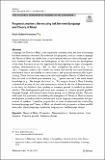Pragmatic markers: the missing link between language and Theory of Mind
Author(s)
Rubio-Fernandez, Paula
Download11229_2020_Article_2768.pdf (602.9Kb)
Publisher with Creative Commons License
Publisher with Creative Commons License
Creative Commons Attribution
Terms of use
Metadata
Show full item recordAbstract
Abstract
Language and Theory of Mind come together in communication, but their relationship has been intensely contested. I hypothesize that pragmatic markers connect language and Theory of Mind and enable their co-development and co-evolution through a positive feedback loop, whereby the development of one skill boosts the development of the other. I propose to test this hypothesis by investigating two types of pragmatic markers: demonstratives (e.g., ‘this’ vs. ‘that’ in English) and articles (e.g., ‘a’ vs. ‘the’). Pragmatic markers are closed-class words that encode non-representational information that is unavailable to consciousness, but accessed automatically in processing. These markers have been associated with implicit Theory of Mind because they are used to establish joint attention (e.g., ‘I prefer that one’) and mark shared knowledge (e.g., ‘We bought the house’ vs. ‘We bought a house’). Here I develop a theoretical account of how joint attention (as driven by the use of demonstratives) is the basis for children’s later tracking of common ground (as marked by definite articles). The developmental path from joint attention to common ground parallels language change, with demonstrative forms giving rise to definite articles. This parallel opens the possibility of modelling the emergence of Theory of Mind in human development in tandem with its routinization across language communities and generations of speakers. I therefore propose that, in order to understand the relationship between language and Theory of Mind, we should study pragmatics at three parallel timescales: during language acquisition, language use, and language change.
Date issued
2020-07-08Department
Massachusetts Institute of Technology. Department of Brain and Cognitive SciencesPublisher
Springer Netherlands